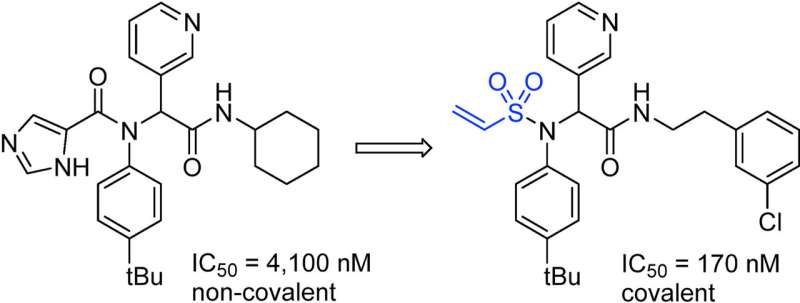Creating an arsenal of COVID-19 therapeutics

It has become clear that we need a variety of tools to effectively control the pandemic. Scientists are shifting their focus towards treatments that can help manage the disease for patients who develop serious symptoms.
Using the Canadian Light Source (CLS) at the University of Saskatchewan, Anthony Mittermaier, Nicolas Moitessier, Martin Schmeing, and their McGill University team have discovered a small molecule that may help combat COVID-19 and could contribute to a new arsenal of treatments slowly making their way to market.
COVID-19 turns your cells into virus factories that make thousands of copies of itself. However, the virus can only replicate this way if it has functioning proteins. The team is focused on small molecules that can bind to these proteins and block the replication process—like throwing a wrench into the machine that builds viruses. These molecules can kill the virus and clear an infection.
"There is a need for therapeutics, in addition to vaccine-related efforts," said Mittermaier, an associate professor in McGill's Department of Chemistry. "As we've become more knowledgeable about how COVID-19 works, it's becoming clear that it will be extremely beneficial to have some additional ways of fighting the pandemic."
He added that we need to turn to additional strategies to tackle COVID-19 in the wake of immune-evading variants and low vaccine uptake across the globe.
"I think it will be really important to eventually find a new normal in which our lives can return to something like what we knew before," said Mittermaier.
The first small molecule therapeutic from Pfizer was recently approved in Canada and it targets the same protein. However, this molecule is different from the one the McGill team analyzed at the CLS. Having a variety of molecules for therapeutics is necessary to prevent the virus from developing resistance.
"It's nice to have a toolbox of different tools to target this. We're looking at the same protein, but what's really important is that our molecule is very different," says Moitessier, a professor in McGill's Department of Chemistry. "If this COVID-19 protein mutates to block the activity of the Pfizer drug, we hope our molecule would still offer effective protection."
There are other benefits to having a therapeutic developed by researchers from a Canadian university. The team is hopeful that its molecule can be effective as an oral treatment for COVID-19 patients, and a Canadian-developed drug might make the treatment more accessible to patients and physicians in Canada.
He added that the synchrotron's crystallography beamline was instrumental in figuring out exactly how the molecule binds to the protein, allowing the researchers to visualize just how effective their molecule is.
"We use software to design these new molecules, then we go to the lab and make them, yet we don't have any proof that it really binds to these proteins. To confirm the mechanism of action or the binding, crystallography was key," said Moitessier.
More information: Julia K. Stille et al, Design, synthesis and in vitro evaluation of novel SARS-CoV-2 3CLpro covalent inhibitors, European Journal of Medicinal Chemistry (2021). DOI: 10.1016/j.ejmech.2021.114046
Provided by Canadian Light Source





















